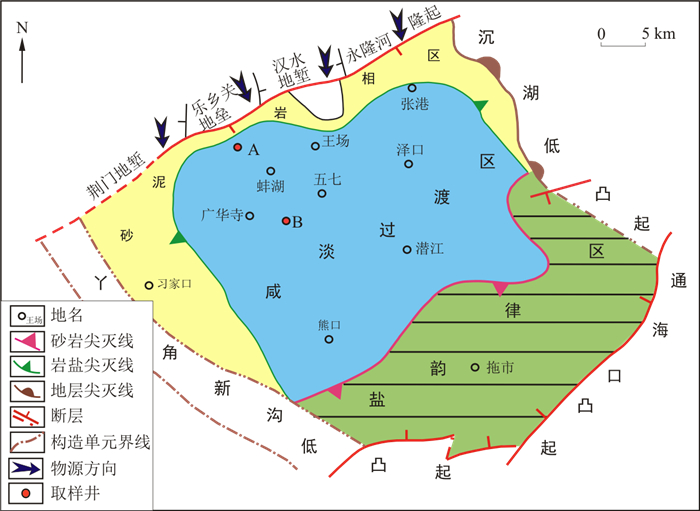Characteristics of pore structure of intersalt shale oil reservoir by low temperature nitrogen adsorption and high pressure mercury pressure methods in Qianjiang Sag
-
摘要: 为了更全面地表征潜江凹陷潜江组页岩油储层孔隙结构特征,系统选取了距物源不同距离的A井和B井多块页岩样品进行了分析测试,通过场发射扫描电镜、低温氮气吸附和高压压汞实验综合分析了页岩孔隙结构特征;通过对比抽提前后场发射扫描电镜图像、低温氮气吸附和高压压汞实验数据,进一步研究了页岩中滞留烃的赋存空间特征;通过对典型页岩样品的二次压汞实验,探讨了页岩中连通孔隙的孔径分布特征。结果显示:潜江凹陷潜江组页岩油储层孔隙大小为纳米-微米级,孔径2~180 nm的黏土矿物层间孔和白云石晶间孔是该区发育最主要的两种孔隙类型;A井页岩中的滞留烃主要赋存在孔径2~20 nm的黏土矿物层间孔中,滞留烃含量较低,连通孔径主要集中在3~15 nm范围内,B井页岩中的滞留烃赋存在孔径8~100 nm的白云石晶间孔中,滞留烃含量多,连通孔径主要分布在10~130 nm范围内;白云石和黏土矿物的存在都有利于页岩储层储集空间的发育,但远离物源的生物成因的白云石更有利于滞留烃的赋存和可动性。研究成果可以为潜江凹陷页岩油的勘探和开发提供一定的理论支撑。Abstract: In order to more comprehensively characterize the pore structure characteristics of Qianjiang Formation shale oil reservoir in Qianjiang Sag, several shale samples from Well A and Well B with different distances from the source were systematically selected for analyzing and testing, and the pore structure characteristics of shale were comprehensively analyzed by field emission scanning electron microscope, low temperature nitrogen adsorption and mercury intrusion capillary pressure experiment; Making a further study by comparing the field emission scanning electron microscope images, low-temperature nitrogen adsorption and mercury intrusion capillary pressure experimental data on the occurrence space characteristics of retained hydrocarbons in shale; The pore size distribution of connected pores in shale is discussed through the secondary mercury injection experiments on typical shale samples.This study shows that the pore size of Qianjiang Formation shale oil reservoir in Qianjiang Sag is nanometer micron scale, and 2-180 nm clay mineral interlayer pore and dolomite intergranular pore are the two main pore types in this area; The retained hydrocarbon in Well A shale mainly exists in 2-20 nm clay mineral interlayer pores, the content of retained hydrocarbon is low, and the connected pore size is mainly concentrated in the range of 3-15 nm.The retained hydrocarbon in Well B shale mainly exists in 8-100 nm dolomite intergranular pores, the amount of retained hydrocarbon is large, and the connected pore size is mainly distributed in the range of 10-130 nm.The existence of dolomite and clay minerals is conducive to the development of shale reservoir space, but the biogenic dolomite far away from the source is more conducive to the occurrence and mobility of retained hydrocarbon.The research results can provide theoretical support for the exploration and development of shale oil in Qianjiang Sag.
-
图 1 潜江凹陷页岩沉积特征及井位分布图[27]
Figure 1. Sedimentary characteristics and well locations of shale in Qianjiang Sag
图 12 潜江凹陷Eq3410韵律页岩样品场发射扫描电镜图像
a.A井,白云石粒间孔,孔径最大为2 μm,未见滞留烃,黏土矿物层间孔孔径多小于200 nm,可见滞留烃;b.A井,黏土矿物层间孔,可见滞留烃富集,孔径最大为500 nm,大部分小于200 nm;c.B井,白云石晶间孔,可见大量滞留烃;d.B井,白云石晶间孔,孔径最大2 μm,部分小于200 nm,可见滞留烃富集;e.B井,抽提前,滞留烃赋存在碳酸盐晶间孔、粒间孔和黏土矿物层间孔中;f.B井,抽提后,孔隙周围有盐类物质析出
Figure 12. Field emission scanning electron microscope images of Eq3410 rhythmic shale samples in Qianjiang Sag
表 1 潜江凹陷Eq3410韵律页岩样品矿物组成和地球化学参数
Table 1. Mineral composition and geochemical parameters of Eq3410 rhythmic shale in Qianjiang Sag
井位 白云石φB/% 黏土矿物φB/% w(TOC)/% S1/(mg·g-1) A 分布范围 3.03~31.9 10.16~37.90 0.77~2.87 0.83~5.87 平均值 19.08 20.26 1.73 3.63 B 分布范围 11.30~52.15 0~19.60 1.15~2.44 3.12~9.85 平均值 35.03 11.38 1.79 6.59 表 2 一次和二次压汞孔隙结构参数
Table 2. First and second mercury intrusion capillary pressure of pore structure parameters
样品 A-4 B-3 B-4 B-5 孔隙度/% 一次 4.590 8 18.025 0 17.472 2 18.728 9 二次 1.476 9 8.636 2 8.941 1 6.978 6 总孔容/(cm3·g-1) 一次 0.019 1 0.086 7 0.081 4 0.086 7 二次 0.004 9 0.026 4 0.027 2 0.030 3 -
[1] 邹才能, 杨智, 崔景伟, 等. 页岩油形成机制、地质特征及发展对策[J]. 石油勘探与开发, 2013, 40(1): 14-26. https://www.cnki.com.cn/Article/CJFDTOTAL-SKYK201301003.htmZhou C D, Yang Z, Cui J W, et al. Formation mechanism, geological characteristics and development strategy of nonmarine shale oil in China[J]. Petroleum Exploration and Development, 2013, 40(1): 14-26(in Chinese with English abstract). https://www.cnki.com.cn/Article/CJFDTOTAL-SKYK201301003.htm [2] 贾承造, 郑民, 张永峰. 中国非常规油气资源与勘探开发前景[J]. 石油勘探与开发, 2012, 39(2): 129-136. https://www.cnki.com.cn/Article/CJFDTOTAL-SKYK201202002.htmJia C Z, Zheng M, Zhang Y F. Unconventional hydrocarbon resources in China and the prospect of exploration and development[J]. Petroleum Exploration and Development, 2012, 39(2): 129-136(in Chinese with English abstract). https://www.cnki.com.cn/Article/CJFDTOTAL-SKYK201202002.htm [3] 王民, 马睿, 李进步, 等. 济阳坳陷古近系沙河街组湖相页岩油赋存机理[J]. 石油勘探与开发, 2019, 46(4): 789-802. https://www.cnki.com.cn/Article/CJFDTOTAL-SKYK201904020.htmWang M, Ma R, Li J B, et al. Occurrence mechanism of lacustrine shale oil in the Paleogene Shahejie Formation of Jiyang Depression, Bohai Bay Basin, China[J]. Petroleum Exploration and Development, 2019, 46(4): 789-802(in Chinese with English abstract). https://www.cnki.com.cn/Article/CJFDTOTAL-SKYK201904020.htm [4] 武晓玲, 高波, 叶欣, 等. 中国东部断陷盆地页岩油成藏条件与勘探潜力[J]. 石油与天然气地质, 2013, 34(4): 455-462. https://www.cnki.com.cn/Article/CJFDTOTAL-SYYT201304007.htmWu X L, Gao B, Ye X, et al. Shale oil accumulation conditions and exploration potential of faulted basins in the east of China[J]. Oil & Gas Geology, 2013, 34(4): 455-462(in Chinese with English abstract). https://www.cnki.com.cn/Article/CJFDTOTAL-SYYT201304007.htm [5] 邹才能, 朱如凯, 白斌, 等. 中国油气储层中纳米孔首次发现及其科学价值[J]. 岩石学报, 2011, 27(6): 1857-1864.Zhou C N, Zhu R K, Bai B, et al. First discovery of nano-pore throat in oil and gas reservoir in China and its scientific value[J]. Acta Petrologica Sinica, 27(6): 1857-1864(in Chinese with English abstract). [6] 陈杰, 周改英, 赵喜亮, 等. 储层岩石孔隙结构特征研究方法综述[J]. 特种油气藏, 2005, 12(4): 11-14, 103. doi: 10.3969/j.issn.1006-6535.2005.04.003Chen J, Zhou G Y, Zhao X L, et al. Review of research methods for pore structure characteristics of reservoir rocks[J]. Special Oil and Gas Reservoirs, 2005, 12(4): 11-14, 103(in Chinese with English abstract). doi: 10.3969/j.issn.1006-6535.2005.04.003 [7] Loucks R G, Reed R M, Ruppel S C, et al. Morphology, genesis, and distribution of nanometer-scale pores in siliceous mudstones of the Mississippian Barnett shale[J]. Journal of Sedimentary Research, 2009, 79(12): 848-861. doi: 10.2110/jsr.2009.092 [8] Loucks R G, Reed R M, Ruppel S C, et al. Spectrum of pore types and networks in mudrocks and adescriptive classification for matrix-related mudrock pores[J]. AAPG Bulletin, 2012, 96(6): 1071-1098. doi: 10.1306/08171111061 [9] 陈尚斌, 朱炎铭, 王红岩, 等. 川南龙马溪组页岩气储层纳米孔隙结构特征及其成藏意义[J]. 煤炭学报, 2012, 37(3): 438-444. https://www.cnki.com.cn/Article/CJFDTOTAL-MTXB201203015.htmChen S B, Zhu Y M, Wang H Y, et al. Structure characteristics and accumulation significance of nanopores in Longmaxi shale gas reservoir in the southern Sichuan Basin[J]. Jounal of China Coal Society, 2012, 37(3): 438-444(in Chinese with English abstract). https://www.cnki.com.cn/Article/CJFDTOTAL-MTXB201203015.htm [10] Abe M. Consideration on organic constituents and lithology of the resource-rocks of petroleum in the Teradomari folding zone, Niigata Oil Field[J]. The Journal of the Japanese Association of Mineralbgists, Petrologists and Economic Geologists, 1959, 43(6): 318-324. doi: 10.2465/ganko1941.43.318 [11] 孙中良, 王芙蓉, 何生, 等. 潜江凹陷古近系盐间典型韵律层页岩孔隙结构[J]. 深圳大学学报: 理工版, 2019, 36(3): 289-297. https://www.cnki.com.cn/Article/CJFDTOTAL-SZDL201903010.htmSun Z L, Wang F R, He S, et al. The pore structures of the shale about typical inter-salt rhythm in the Paleogene of Qianjiang Depression[J]. Journal of Shenzhen University: Science and Engineering Edition, 2019, 36(3): 289-297(in Chinese with English abstract). https://www.cnki.com.cn/Article/CJFDTOTAL-SZDL201903010.htm [12] 赖锦, 王贵文, 陈敏, 等. 基于岩石物理相的储集层孔隙结构分类评价: 以鄂尔多斯盆地姬塬地区长8油层组为例[J]. 石油勘探与开发, 2013, 40(5): 566-573. https://www.cnki.com.cn/Article/CJFDTOTAL-SKYK201305009.htmLai J, Wang G W, Chen M, et al. Pore structures evaluation of low permeability clastic reservoirs based on petrophysical facies: A case study on Chang 8 reservoir in the Jiyuan region, Ordos Basin[J]. Petroleum Exploration and Development, 2013, 40(5): 566-573(in Chinese with English abstract). https://www.cnki.com.cn/Article/CJFDTOTAL-SKYK201305009.htm [13] Foster A G. Pore size and pore distribution[J]. Discussions of the Faraday Society, 1948, 3(1): 41-51. http://xlink.rsc.org/?DOI=DF9480300041 [14] 孟子圆, 孙卫, 刘登科, 等. 联合压汞法的致密储层微观孔隙结构及孔径分布特征: 以鄂尔多斯盆地吴起地区长6储层为例[J]. 地质科技情报, 2019, 38(2): 208-216. https://www.cnki.com.cn/Article/CJFDTOTAL-DZKQ201902024.htmMeng Z Y, Sun W, Liu D K, et al. Combined mercury porosimetry to characterize the microscopic pore structure and pore size distribution of tight reservoirs: A case of Chang 6 reservoir in Wuqi area, Ordos Basin[J]. Geological Science and Technology Information, 2019, 38(2): 208-216(in Chinese with English abstract). https://www.cnki.com.cn/Article/CJFDTOTAL-DZKQ201902024.htm [15] 朱日房, 张林晔, 李钜源, 等. 页岩滞留液态烃的定量评价[J]. 石油学报, 2015, 36(1): 13-18. https://www.cnki.com.cn/Article/CJFDTOTAL-SYXB201501002.htmZhu R F, Zhang L Y, Li J Y, et al. Quantitative evaluation of residual liquid hydrocarbons in shale[J]. Acta Petrolel Sinica, 2015, 36(1): 13-18(in Chinese with English abstract). https://www.cnki.com.cn/Article/CJFDTOTAL-SYXB201501002.htm [16] 赵贤正, 周立宏, 蒲秀刚, 等. 湖相页岩滞留烃形成条件与富集模式: 以渤海湾盆地黄骅坳陷古近系为例[J]. 石油勘探与开发, 2020, 47(5): 856-869. https://www.cnki.com.cn/Article/CJFDTOTAL-SKYK202005004.htmZhao X Z, Zhou L H, Pu X G, et al. Formation conditions and enrichment model of retained petroleum in lacustrine shale: A case study of the Paleogene in Huanghua Depression, Bohai Bay Basin, China[J]. Petroleum Exploration and Development, 2020, 47(5): 856-869(in Chinese with English abstract). https://www.cnki.com.cn/Article/CJFDTOTAL-SKYK202005004.htm [17] Liao Z, Geng A, Graciaa A, et al. Saturated hydrocarbons occluded inside asphaltene structures and their geochemical significance, as exemplified by two Venezuelan oils[J]. Organic Geochemistry, 2006, 37(3): 291-303. doi: 10.1016/j.orggeochem.2005.10.010 [18] 包友书. 渤海湾盆地东营凹陷古近系页岩油主要赋存空间探索[J]. 石油实验地质, 2018, 40(4): 479-484. https://www.cnki.com.cn/Article/CJFDTOTAL-SYSD201804004.htmBao Y S. Effective reservoir spaces of Paleogene shale oil in the Dongying Depression, Bohai Bay Basin[J]. Petroleum Geology & Experiment, 2018, 40(4): 479-484(in Chinese with English abstract). https://www.cnki.com.cn/Article/CJFDTOTAL-SYSD201804004.htm [19] 宁方兴, 王学军, 郝雪峰, 等. 济阳坳陷页岩油赋存状态和可动性分析[J]. 新疆石油天然气, 2015, 11(3): 1-6. doi: 10.3969/j.issn.1673-2677.2015.03.001Ning F X, Wang X J, Hao X F, et al. Occurrence and mobility of shale oil in Jiyang Depression[J]. Xinjiang Oil & Gas, 2015, 11(3): 1-6(in Chinese with English abstract). doi: 10.3969/j.issn.1673-2677.2015.03.001 [20] 李浩, 陆建林, 王保华, 等. 渤海湾盆地东濮凹陷陆相页岩油可动性影响因素与资源潜力[J]. 石油实验地质, 2020, 42(4): 632-638. https://www.cnki.com.cn/Article/CJFDTOTAL-SYSD202004020.htmLi H, Lu J L, Wang B H, et al. Controlling factors of continental shale oil mobility and resource potential in Dongpu Sag, Bohai Bay Basin[J]. Petroleum Geology & Experiment, 2020, 42(4): 632-638(in Chinese with English abstract). https://www.cnki.com.cn/Article/CJFDTOTAL-SYSD202004020.htm [21] 刘向君, 熊健, 梁利喜, 等. 基于微CT技术的致密砂岩孔隙结构特征及其对流体流动的影响[J]. 地球物理学进展, 2017, 32(3): 1019-1028. https://www.cnki.com.cn/Article/CJFDTOTAL-DQWJ201703010.htmLiu X J, Xiong J, Liang L X, et al. Study on the characteristics of pore structure of tight sand based on micro-CT scanning and its influence on fluid flow[J]. Progress in Geophysics, 2017, 32(3): 1019-1028(in Chinese with English abstract). https://www.cnki.com.cn/Article/CJFDTOTAL-DQWJ201703010.htm [22] 赵建鹏, 崔利凯, 陈惠, 等. 基于CT扫描数字岩心的岩石微观结构定量表征方法[J]. 现代地质, 2020, 34(6): 1205-1213. https://www.cnki.com.cn/Article/CJFDTOTAL-XDDZ202006011.htmZhao J P, Cui L K, Chen H, et al. Quantitative characterization of rock microstructure of digital core based on CT scanning[J]. Geoscience, 2020, 34(6): 1205-1213(in Chinese with English abstract). https://www.cnki.com.cn/Article/CJFDTOTAL-XDDZ202006011.htm [23] 刘震, 黄艳辉, 潘高峰, 等. 低孔渗砂岩储层临界物性确定及其石油地质意义[J]. 地质学报, 2012, 86(11): 1815-1825. doi: 10.3969/j.issn.0001-5717.2012.11.011Liu Z, Huang Y H, Pan G F, et al. Determination of critical physical properties of low porosity and permeability sandstone reservoir and its petroleum geological significance[J]. Acta Geologica Sinica, 2012, 86(11): 1815-1825(in Chinese with English abstract). doi: 10.3969/j.issn.0001-5717.2012.11.011 [24] 张安达, 王成, 乔睿. 致密砂岩储层物性下限确定新方法及系统分类[J]. 岩性油气藏, 2014, 26(5): 5-8. doi: 10.3969/j.issn.1673-8926.2014.05.002Zhang A D, Wang C, Qiao R, et al. A new method for determining physical property lower limit of tight sandstone reservoir and reservoir system classification[J]. Lithologic Reservoirs, 2014, 26(5): 5-8(in Chinese with English abstract). doi: 10.3969/j.issn.1673-8926.2014.05.002 [25] 陈开远, 何胡军, 柳保军, 等. 潜江凹陷潜江组古盐湖沉积层序的地球化学特征[J]. 盐湖研究, 2002, 10(4): 19-24. doi: 10.3969/j.issn.1008-858X.2002.04.003Zhang K Y, He H J, Liu B J, et al. Geochemical characteristics of paleo salt lake sedimentary sequence of Qianjiang Formation in Qianjiang Sag[J]. Journal of Salt Lake Research, 2002, 10(4): 19-24(in Chinese with English abstract). doi: 10.3969/j.issn.1008-858X.2002.04.003 [26] 陈凤玲. 潜江盐湖构造演化及沉积充填与油气成藏[J]. 石油天然气学报, 2007, 29(2): 50-53, 148. doi: 10.3969/j.issn.1000-9752.2007.02.012Chen F L. Tectonic evolution, sedimentary filling and hydrocarbon accumulation of Qianjiang Salt Lake[J]. Journal of Oil and Gas Technology, 2007, 29(2): 50-53, 148(in Chinese with English abstract). doi: 10.3969/j.issn.1000-9752.2007.02.012 [27] 万赟来, 胡明毅, 胡忠贵, 等. 盐湖盆地浅水三角洲沉积模式: 以江汉盆地潜江凹陷新沟咀组为例[J]. 沉积与特提斯地质, 2011, 31(2): 55-60. doi: 10.3969/j.issn.1009-3850.2011.02.008Wang Y L, Hu M Y, Hu Z G, et al. Sedimentary model of shallow water delta in salt lake basin: A case study of Xingouzui Formation in Qianjiang Sag, Jianghan Basin[J]. Sedimentary Geology and Tethyan Geology, 2011, 31(2): 55-60(in Chinese with English abstract). - doi: 10.3969/j.issn.1009-3850.2011.02.008 [28] 熊智勇, 吴世强, 王洋, 等. 江汉盐湖盆地盐间泥质白云岩油藏地质特征与实践[J]. 地质科技情报, 2015, 34(2): 181-187. https://www.cnki.com.cn/Article/CJFDTOTAL-DZKQ201502027.htmXiong Z Y, Wu S Q, Wang Y, et al. Geological characteristics and practice of inter salt argillaceous dolomite reservoir in Jianghan Salt Lake Basin[J]. Geological Science and Technology Information, 2015, 34(2): 181-187(in Chinese with English abstract). https://www.cnki.com.cn/Article/CJFDTOTAL-DZKQ201502027.htm [29] Haul R H. Adsorption, surface area and porosity[M]. London, New York: Academic Press, 1967: 371. [30] 王民, 关莹, 李传明, 等. 济阳坳陷沙河街组湖相页岩储层孔隙定性描述及全孔径定量评价[J]. 石油与天然气地质, 2018, 39(6): 1107-1119. https://www.cnki.com.cn/Article/CJFDTOTAL-SYYT201806003.htmWang M, Guan Y, Li C M, et al. Qualitative description and full-pore-size quantitative evaluation of pores in lacustrine shale reservoir of Shahejie Formation, Jiyang Depression[J]. Oil & Gas Geology, 2018, 39(6): 1107-1119(in Chinese with English abstract). https://www.cnki.com.cn/Article/CJFDTOTAL-SYYT201806003.htm [31] Sun M D, Zhang L H, Hu Q H, et al. Multiscale connectivity characterization of marine shales in southern China by fluid intrusion, small-angle neutron scattering (SANS), and FIB-SEM[M]. [S. l. ]: MPG, 2020: 112. [32] 吴世强, 陈凤玲, 姜在兴, 等. 江汉盆地潜江凹陷古近系潜江组白云岩成因[J]. 石油与天然气地质, 2020, 41(1): 201-208. https://www.cnki.com.cn/Article/CJFDTOTAL-SYYT202001019.htmWu S Q, Chen F L, Jiang Z X, et al. Origin of Qianjiang Formation dolostone in Qianjiang Sag, Jianghan Basin[J]. Oil & Gas Geology, 2020, 41(1): 201-208(in Chinese with English abstract). https://www.cnki.com.cn/Article/CJFDTOTAL-SYYT202001019.htm -





 下载:
下载:
















